Zelda: The Wand of Gamelon - Fast Facts
The following are a bunch of miscellaneous facts relating to Zelda: The Wand of Gamelon that are not noteworthy enough to get their own page. Consider this page (as well as its siblings) a crash course of useless CD-i Nintendo information!
Fact Links:
Cut Cutscene Backgrounds -- Cutscene Frames On The Cover Art -- DiC Outfit Cameo -- Dynamic Music -- Early Game Blurb -- The Four Animators Misconception -- How Much Time Is "LATER STILL"? -- Inaccessible Attic In Kobitan -- King Harkinian's Dinner Bell -- Nintendo's Involvement In This Title -- No-Cutscene Zones -- The Post-Soviet Connection -- Promotional Poster -- Real-Life Artwork -- Reuse and Recycle -- Unused Heart Sprite -- Unused Laser Lords Font Reusage -- Why Sidescrolling?
Cut Cutscene Backgrounds
The data for Zelda: The Wand of Gamelon contains four unused cutscene backgrounds - two for the intro and two for the outro.
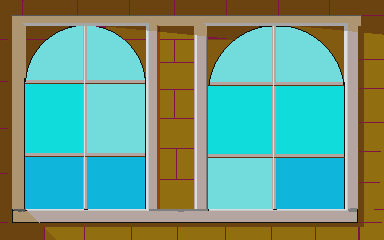

The ones for the intro look very familiar... they're actually recolored versions of backgrounds that were used in the intro of Link: The Faces of Evil (specifically, in the Link and Harkinian scenes). Furthermore, the first background was recolored again and used in the ending of The Wand of Gamelon during Lord Kiro's scenes. It's unknown where exactly these backgrounds would've been used in the intro.
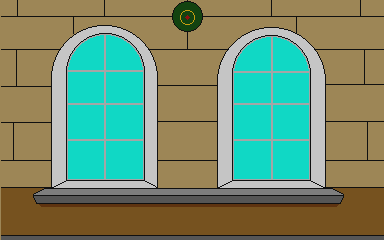
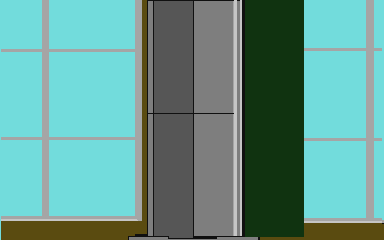
The two ending backgrounds are (more-or-less) completely new backgrounds that just never got used. It's hard to say where the first one would've gone, though the second one seems to belong to the zoom-ins in the Zelda + Lady Alma scene.
Cutscene Frames On The Cover Art
On the box art for both Animation Magic Zelda games, several characters and bosses can be seen next to Link and Zelda. Each character's artwork corresponds to one frame in a cutscene that they star in. This implies (but does NOT confirm) that some of the original cutscene artwork was repurposed for the two games' box art. I've managed to track all of the frames down.
Here are the corresponding frames for Zelda: The Wand of Gamelon:
| Character | Origin Cutscene | Frame No. |
|---|---|---|
| Impa | Most boss intros | 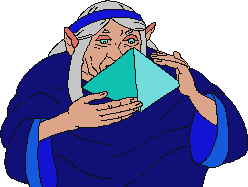
Frame 19 |
| King Harkinian | Introduction | 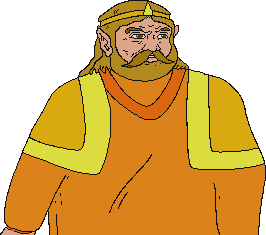
Frame 132 of 669 |
| Mayor Cravendish | Impa At Tykogi Tower | 
Frame 65 of 103 |
| Makoto | Makoto's Starving | 
Frame 30 of 73 |
| Ganon | Ganon Retaliates | 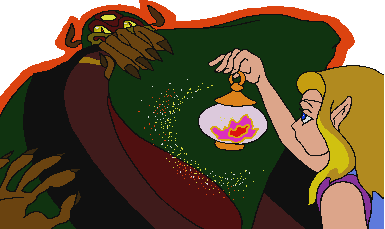
Frame 26 of 80 |
| Gibdo | Gibdo's Introduction | 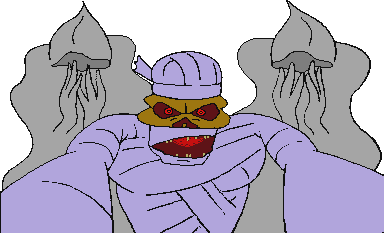
Frame 40 of 116 (head only) |
| Harbanno | Harbanno Escapes | 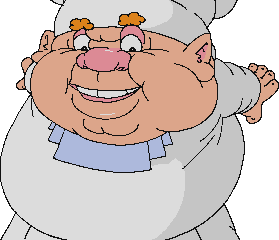
Frame 49 of 113 |
DiC Outfit Cameo
Animation Magic was somewhat lax when it came to staying on-model during the animation of cutscenes. While this does negatively impact the quality of their animations, it results in each artist's style becoming more apparent than usual, and it's fun seeing the little design variations between each cutscene. I think the best example of this would be the Lubonga and Lika cutscenes from Zelda: The Wand of Gamelon. Why's that?
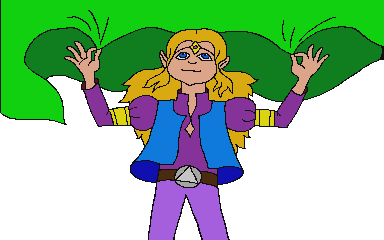
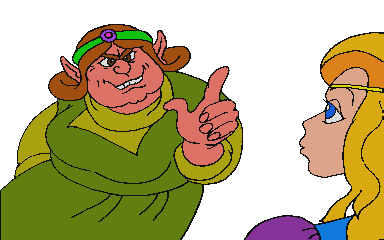
It's because in those cutscenes, and ONLY those cutscenes, Zelda is wearing the outfit she was seen wearing in DiC's The Legend of Zelda cartoon. That cartoon was highly influential to the cutscenes and overall design of Animation Magic's Zelda titles, and this is one of the more blatant examples. I like to think they were two of the first cutscenes made before Zelda's design was finalized, though it's equally likely the same animator did both of these scenes and nothing else.
Dynamic Music
According to Dale DeSharone, the director of Link: The Faces of Evil and Zelda: The Wand of Gamelon, the developers wanted to put a dynamic music system into the two games. In short, the music would have changed according to the gameplay. However, the fact that the music was being streamed from the CD resulted in the idea being scrapped. This fact could explain why so much stage music stems from "base" tracks that change instruments depending on the area. Doing it that way would make the hypothetical dynamic music system sound more seamless.
This idea would not go to waste, however. A dynamic music system would be implemented into I. M. Meen and Chill Manor, with the music changing whenever a enemy attacks the player.
Early Game Blurb
Packaged with early CD-i titles was a catalog that contained a list of released and upcoming titles for the system. This catalog was updated a few times, and appears to have stopped being used around 1993 or 1994. A specific late 1992 catalog (packaged with Laser Lords and likely several other titles) had early (and mistake-filled) plot descriptions for four of the CD-i Nintendo titles. This includes The Faces of Evil, The Wand of Gamelon, Hotel Mario, and Super Mario's Wacky Worlds - unfortunately, none of the other titles got a mention.
This is the blurb for Zelda: The Wand of Gamelon:
ZELDA: WORLD OF GAMELON Join Zelda and her faithful nurse on a
rescue mission fraught with danger. They fight their way across the island of Gamelon to
reclaim the Triface of Courage and rescue Zelda's father.
It's pretty close to how the final game plays out, though there are some silly mistakes. World of Gamelon? The TRIFACE of Courage? Come on.
(This blurb would also appear in Electronics Boutique's Christmas 1993 catalog.)
The Four Animators Misconception
One of the most prevalent facts about the CD-i Nintendo games (apart from Nintendo having no involvement in their development) is how Animation Magic had a team of four Russian animators working in an apartment for six months to create the cutscenes for their Zelda titles. This is only a partial truth - the timeframe is correct, the apartment is a half-truth, and the team of four is false. Here's why:
- Firstly, the credits for both Link: The Faces of Evil and Zelda: The Wand of Gamelon have 25 animators listed, and that's not including technicians or camera operators. So it wasn't just a team of four. Given the scenario and following facts, it's more likely that they initially hired six animators and brought them to the USA, with the rest working in Animation Magic's Saint Petersburg subsidary.
- Secondly, the source of this fact - an interview with game director Dale DeSharone - mentions that they found six 2D animators in Saint Petersburg to work on their project, and brought them over to that apartment workspace. (Also, Dale says that they were working in a couple of apartments, and not just one.) This is also mentioned in an interview with Denis Chernov, one of the games' animators.
- Another interesting thing is that Dale does mention four artists as part of Animation Magic in that interview, and there are four artists in the credits of both games - those being the two background painters and two sprite artists. However, he notes that were done at Animation Magic's Cambridge office, and were not done by the team from Russia. (As a matter of fact, it seems they hadn't been hired yet!)
I think that this artists fact was confused at some point with the animators one, and nobody bothered to actually fact-check it.
So, a more accurate version of the fact would be that Animation Magic initially brought over six animators from Russia to have them work in a couple of apartments for six months, and then later hired nineteen more animators to work solely in Russia as the company grew. But that's more clunky and doesn't invoke the "LOL THE CD-I GAMES WERE BADLY MADE AND RUSHED!!!!!!1" tones as much as the incorrect version.
Hm.
How Much Time Is "LATER STILL"?
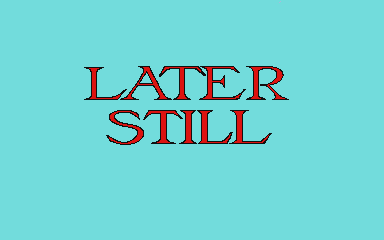
In the intro of Zelda: The Wand of Gamelon, there are two text interludes that convey the passage of time. The first of them is very specific - it states "ONE MONTH LATER" and is backed up by Zelda's dialogue immediately after the interlude. The other one, stating "LATER STILL", is... less helpful. How long is LATER STILL in the CD-i Zelda universe?
Well, it's at least one month. The game's manual states that King Harkinian sailed to Gamelon "months ago", and we already have one month accounted for in the previous interlude. It can't be "months" unless more than one month has happened, so there. We don't have an upper limit to the length of one LATER STILL, and that is a funny thing you can play with.
(I can't believe Zelda took nineteen years to finally get around to saving King Harkinian and Link. What is her problem?)
Inaccessible Attic In Kobitan
There's an oddity regarding this house in Kobitan:
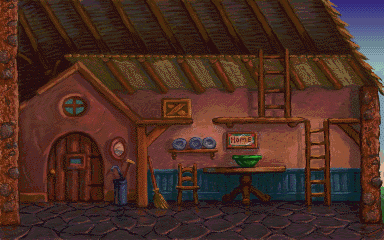
It's home to both the Lantern item and a seemingly-accessible attic that Zelda cannot access. From what can be gathered from the map, the player was meant to climb the top ladder and, presumably, cause enemies to spawn in front of the door. They were then meant to sneak through the attic and drop through a hole in the ceiling near the door, giving them an advantage over the foes.
However, Zelda cannot actually enter the attic, likely due to how the game handles collision at the top and bottom of a map. The highest platform she can climb up to is the second rung on the top ladder. If Zelda tries to get into the attic anyways, she'll hit the top of the screen and either fall to the floor or back to where she started.
King Harkinian's Dinner Bell
In the intro of Zelda: The Wand of Gamelon, King Harkinian's remark about wondering what's for dinner comes across as random... at first. However, if you pay attention to the audio during that scene, you'll notice a bell-like instrument playing before King Harkinian wonders what's for dinner.
This is NOT part of the background music. I've managed to identify the original audio as a stock triangle sound from Sound Ideas, meaning that this sound and corresponding dialogue was very much intentional. This fact feels like it should be more well-known already, but it isn't. (You can read up on what sound was used here.)
Furthermore, there might be a second dinner bell sound in the ending cutscene, at the beginning of the scene where Zelda says "we were just about to have a feast". However, I can't figure out the stock sound effect used, or if it's even a sound effect at all.
Nintendo's Involvement In This Title
A fact often stated about the CD-i Nintendo games is that Nintendo themselves had little to no involvement in their creation, and that the developers were more or less given free reign to do weird things with the franchises. There also happen to be interviews with people who worked on the four released titles (plus an unreleased one), with at least one of the questions focusing on Nintendo's involvement. So I wonder... for this game, how true is that statement?
For Zelda: The Wand of Gamelon: We have an interview with the game's late director, Dale DeSharone. In it, he confirms that Nintendo approved the two titles' design documents and their character sketches - specifically focusing on how Link and Zelda looked - and that was about it. It appears that the fact is true, at least for this game.
No-Cutscene Zones
Across both of Animation Magic's Zelda titles, only two levels have no cutscenes whatsoever - those being Dordung Cave and Gobiyan Ship from Zelda: The Wand of Gamelon. Every other level has at least one cutscene associated with them.
The Post-Soviet Connection
Let's lay down some facts about the origins of Animation Magic and the political climate back in the early 90s:
- The Soviet Union dissolved on December 26th, 1991, ending the Cold War between it and the United States. As a result, companies were more willing to work in both countries at the same time.
- An interview in the book Hammer and Silicon: The Soviet Diaspora in the US Innovation Economy confirms that Animation Magic was founded in 1991, with their Russian subsidary founded in 1992. No specific months/days were listed.
- The earliest date associated with the Animation Magic Zelda games is April 1992. This is the date listed on the finalized overworld map sketches of Koridai and Gamelon. It's likely development started before April as there are earlier concept drawings of the overworld maps, though this is currently unconfirmed.
This gives us a roughly four month time period between the dissolution of the Soviet Union and Animation Magic starting work on their Zelda titles (and likely hiring their Russian animators). This would make Animation Magic one of the first post-Cold War US companies to outsource to Russia, if not the first. However, it's hard to say for sure without more specific dates as well as analysis of other companies that worked with immediately-post-Soviet Union Russia.
Promotional Poster
To promote the Animation Magic Zelda games, Philips had promotional posters made for them. They feature the box artwork of Link and Zelda in the highest quality they've ever been, as well as some neat-looking border graphics and some promotional text. It's likely that other promotional posters were made for certain CD-i titles (maybe Hotel Mario or Burn:Cycle), but these are the only two that I've been able to confirm.
These posters were unheard of until 2019, when an eBay seller listed one of each poster for about $40 plus $20 shipping. The seller's family owned printing companies in Tennessee that worked with Philips and Magnavox, and was also selling some posters relating to the Odyssey console series. It's very likely that these are the only copies of the posters left in existence. I wish I had the money to buy one of them! :(
Here is the promo poster for Zelda: The Wand of Gamelon:

Real-Life Artwork
There's something unique about the background artwork of Zelda: The Wand of Gamelon. Several locations feature paintings and statues of varying sorts, and while a few are too small and pixelated to make out, some can be clearly made out. A handful of them actually use real-life artwork taken from medieval/Renaissance sources.
Here is a list of identified pieces, side-by-side for comparison pleasures:
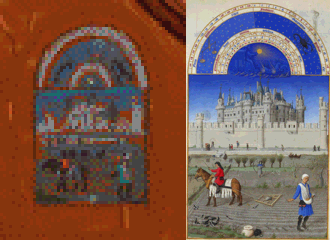
Lika's House in Sakado: Unknown Artist - October Artwork from the Très Riches Heures du Duc de Berry

Tower House in Sakado: Rob Dunlavey & Tom Curry - Gamelon World Map Artwork from Zelda: The Wand of Gamelon
Barely counts, but it's still art sourced from elsewhere

Gobiyan Ship Cabin: Rob Dunlavey & Tom Curry - Gamelon World Map Artwork from Zelda: The Wand of Gamelon
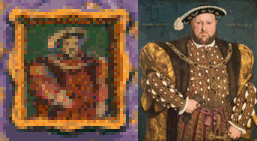
Main Hall of Dodomai Palace: Hans Holbein the Younger - Portrait of Henry VIII
Many replicas exist of the lost original - this one from the National Gallery of Ancient Art in Rome is the closest equivalent
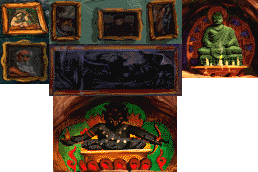
Above are several additional artworks that are likely sourced from real examples. Can you figure them out?
I previously thought that the top-left painting was The Jewish Bride by Rembrandt, but now I'm not so sure. I also know the top-right sculpture is of the Buddha - I'm looking for its origin specifically.
Let me know if you've made a match, and I'll credit you.
Reuse and Recycle
Animation is hard work, and it often leads to shortcuts such as reusing frames in one scene for another. The CD-i Nintendo games were made on a budget and time limit, so it comes as no surprise that they recycle frames between cutscenes. Let's learn about some examples, shall we?
(Instances of frame reuse in the same cutscene and shortened/identical cutscene variants will not be counted. We're reusing frames across 2+ different cutscenes here.)
For Zelda: The Wand of Gamelon:
- Three of Impa's cutscenes start with the same animation, which vary in length between each scene. Here it is in its longest form, taking up almost half of the Tykogi Tower cutscene:
- The animation of Ganon being sucked into a book (of Koridai) was taken from Link: The Faces of Evil.

Unused Heart Sprite
There's an unused sprite of a heart within the data of Zelda: The Wand of Gamelon:

It's around the same size as an item pickup sprite and features a cycling palette, which the pickup sprites usually have. From this, it's safe to say the sprite was meant for the Life Hearts dropped by Iron Knuckle and Hektan. Iron Knuckle already drops a key, but there's no reason why Hektan couldn't have used it...
Unused Laser Lords Font Reusage
Initially, the CD-i game Laser Lords was going to be released on the PC under the name StarTribes: Myth of the Dragon Lord. Several screenshots were released to the BBSes of the day, but ultimately it got sent over to the CD-i realm during Spinnaker Software's twilight years. These screenshots were preserved on the GIFs Galore CD-ROM by Walnut Creek CDROM, and were forgotten about until a Twitter bot shared them and someone recognized them. You can read more about this fun tidbit here.
So what does this bit of trivia have to do with CD-i Zelda? Well, there were two more images of StarTribes on the disc that weren't picked up by the discoverers of that find, and both of them show proper gameplay. Here they are:

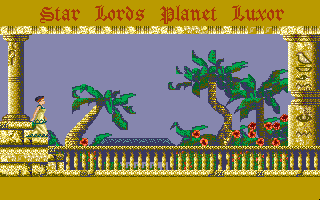
(I'm posting both of them here as I plan to expand this site to cover CD-i Zelda-adjacent titles, such as I.M. Meen, Pyramid Adventures and, well, Laser Lords. One day...)
Notice anything... familiar about the font on the Planet Luxor image? That's because it's using an earlier version of the menu font from Animation Magic's Zelda titles! This makes a lot of sense when you consider that Animation Magic was made up of ex-Spinnaker employees, specifically from their CD-i team. They likely decided to reuse assets they already had.
Here's a comparison of the two:

The difference lies within the capital letters - the S is a lot rougher-looking while the L is missing a single pixel near the top-left. From my lone playthrough of Laser Lords, I can safely say that this font was never used in that game.
Why Sidescrolling?
So... why did Animation Magic decide to make their Zelda games side-scrollers, apart from being inspired by Zelda II? Well, in this interview with the games' late director, Dale DeSharone, it was a decision made by Animation Magic to appeal to Philips, as they were more concerned about their titles having stronger graphics that were distinct from other game consoles' output than gameplay.
(It seems that certain game companies nowadays are following in Philips' footsteps LUL)
Return to top
Last updated: August 13th, 2025.